Now more than ever there’s an added pressure on teams to produce talent internally. As football begins its slow process of returning to normal – whatever normal now means – managers and chief executives alike speak of the change in the financial landscape that will have an impact beyond empty stadiums and postponed open-top bus tours. This demise in revenue will force clubs to look deeper into their ranks, attempting to identify talent ready to step-up to a bigger stage, removing the need to open the proverbial cheque book.
It’s become a wearing cliche that a manager’s fuse is lit the moment their name is stuck onto the office door; immediately burning at an uncontrollable speed towards an inevitable sacking at the first sign of trouble. With such an indefinite life span, its no wonder that managers are so quick to dive into the transfer market looking for an impactful marquee signing that will underpin their reign. What is too often overlooked by the revolving door managerial cycle is the youngster who signed as a pre-teen, working tirelessly through the ranks towards the dream of signing a professional contract.
In this data analysis, we look at the attacking talent within the English Youth league, looking to identify players who might be ready to take the next step towards the Premier League.
The Data
Such is the nature of youth football, games are low in attendance and often go under the radar across the football population. This applies to coding too, as Wyscout continue to extend their all-seeing scouting range, some youth league games are still not coded to the level that you get from say, a Premier League game.
To mitigate this issue as much as possible the following parameters and filters were implemented in order to produce an as-cleansed-as-possible pool of players for analysis.
- Player’s must be registered to a club within the England U18 Youth League
- Player’s must have played over 500 minutes of League football in the 2019/20 season
- Player’s must be between 16-19 years old
- Players position must be either CAM, RW, LW, ST, or any combination of these
The results produced data for 43 attacking youngsters, which we have analysed further below.
Playing Style
The first visual is a ternary graph. This graph measures the players on three key metrics that accurately depict a player’s attacking style. Using barycentric coordinates, which essentially means all the metrics work in close relationship with each other, we are able to visually depict individual playing styles using the data, shown below.
Be sure to note that the closer to a corner a player’s marker is situated, it indicates the level of orientation their style has towards that metric, not their ability/success in that particular area. In simple terms, it is an indication of playing-style, not skill level. It follows then that the central markers are players with a more balanced attacking style.
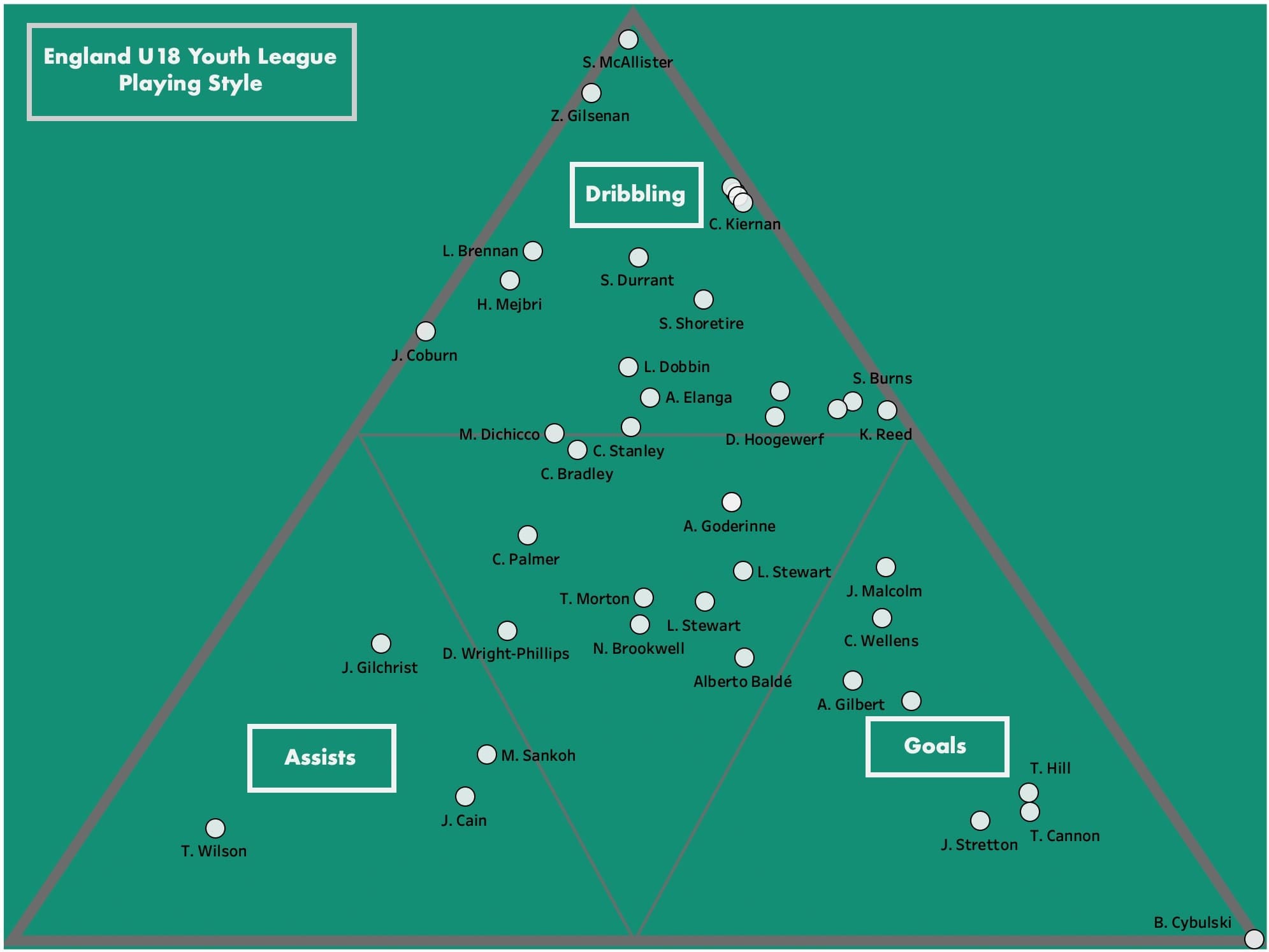
Naturally, the immediate observations made on this visual are towards the extreme values – the corners. The goal-orientated players which are quickly identifiable include 18-year-old Thomas Cannon of Everton. Before the cancellation of the season, Everton U18s sat in third position in the U18 Premier League with 31 points. Cannon’s attacking prowess and orientation towards goal-scoring saw him net an impressive 16 times, a third of Everton’s total (48).
Liverpool’s 18-year-old midfielder, Jake Cain, is another player who stands out on the visual. The young midfielder made seven assists and scored six goals in his U18 league appearances, earning him starts with the U23 side.
In the final corner, Australian Zak Gilsenan of Blackburn Rovers is a player whose style centres around dribbling and technical play. The 17-year-old played 663 minutes for the Blackburn U18 side scoring one goal. We will look further into measuring his ability through analysis later on in the article.
Now we’ve looked at the playing-style of each player in the dataset, let’s look closer at their ability.
Attacking
This section measures each player using metrics focused on goal-scoring. The first graph, shown below, cross-references xG90 against goals per 90. This test will show us which players are outperforming their expected goals, indicating how clinical they are when finishing and which players are underperforming against their xG metric.
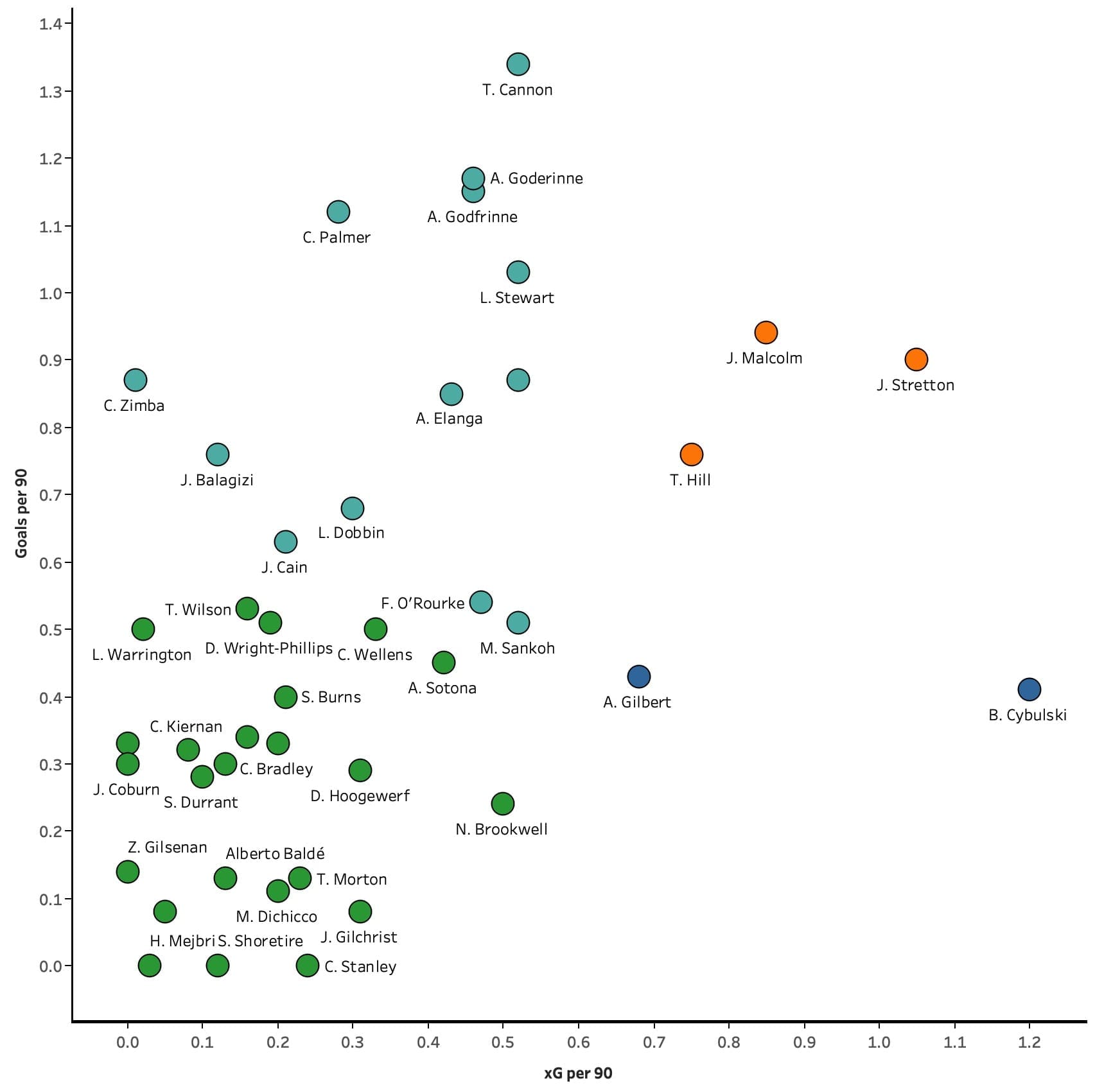
As we can see above, the players have been split into four clusters to assist in identifying talent, as follows:
- Green: Low-goalscoring scores
- Dark Blue: Underperforming against xG
- Orange: Good goal-scorers
- Light Blue: Overperforming against xG
Youngster Tom Cannon’s finishing ability stands out in this graph. The Everton man averages 1.34 goals per 90, with an xG90 of just 0.52. The Irishman who moved from the Everton youth team into the U18s back in July 2019 is yet to sign a professional contract and is certainly one to watch as time progresses.
Jack Stretton of Derby is another player who stands out in this visual. The Scottish striker scored 12 goals for Derby U18s in the 2019/20 season averaging 0.9 goals per game. This is in line with his xG90 of 1.05, showing the youngster’s ability to take chances when they arise.
Bartosz Cybulski is another Derby U18 striker worth a mention. The Pole scored just three in the season, averaging just 0.41 per 90. However, the 17-year-old managed an xG90 of 1.2, more than any other player. This shows that despite either bad variance or a need to improve finishing, the youngster has the ability to find goal-scoring opportunities.
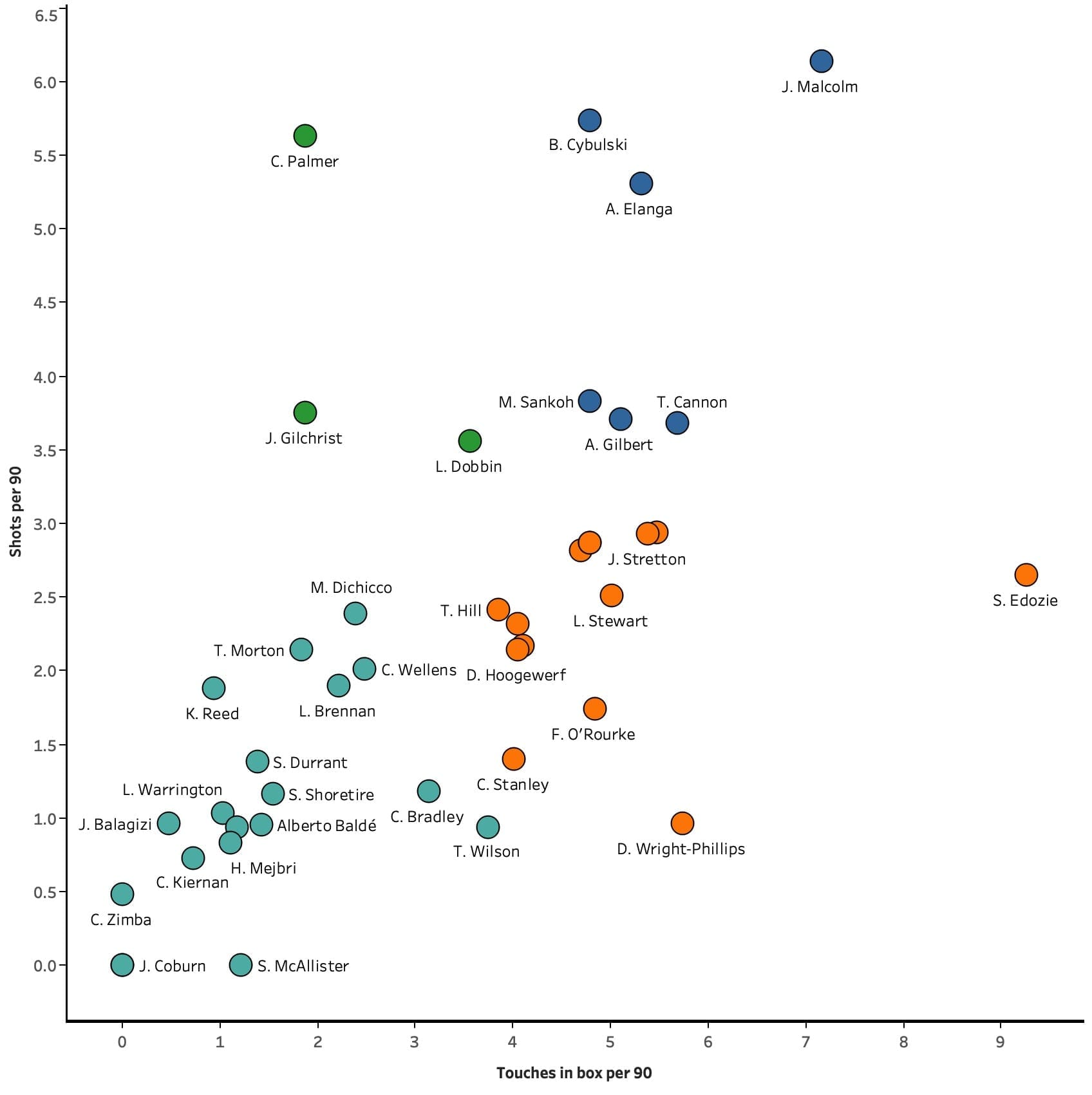
The next visual continues to look at the goalscoring threat posed by each attacker in the data set. This graph cross-references each player’s number of touches in the penalty box per 90 (TiP90) against the number of shots taken per 90. This test will identify those who are adept at finding space in congested areas – demonstrating good awareness and off the ball movement. It also identifies those with the ability to use that space and turn it into a shot at goal.
Other than the players already mentioned, Jovan Malcolm, the English forward playing at West Brom is quickly identifiable as a player that can find space in the box. The youngster averages 7.16 TiP90 and 6.14 shots per 90. This has led to the striker scoring nine goals this season achieving an xG90 of 0.85.
Another standout is Sam Edozie of Man City. The 17-year-old is more of a winger than a striker, which goes some way to explain his high TiP90 of 9.26 compared to his lower shots per 90 of 2.65. From the first visual we can see the winger’s game is focussed towards dribbling and chance creation, as opposed to goal-scoringm. Therefore, these numbers provide some further context, as the touches in the box will be from dribbles where the youngster is looking to penetrate defensive structures and create for his teammates. However, as we see in later tests, the youngster’s passing can let him down.
Cole Palmer, also of Man City, is an exciting attacking midfielder who averages an impressive 5.63 shots per 90 and just 1.88 TiP90. Due to his positioning, this makes sense as a lot of his shots will be from distance. This is supported by his 0.29 xG90, as longer shots yield a smaller xG. What is impressive, however, is the 17-year-old averages 1.12 goals per 90, scoring 15 in total for the season. On top of this, the youngster boasts a goal contribution of 35% for Man City U18s. These statistics highlight a player who is playing above the level of U18 football. Personally, I am excited to see him progress and maybe follow in the footsteps of Phil Foden.
An attacker is more than just goals, that’s why in the next section we look at the player’s who excel in the creative side of attack.
Creativity
The first test cross-references the player’s xA90 against their number of smart passes made per 90. According to Wyscout, a smart pass is… a pass that has some idea to it. It must be creative and cut the lines, penetrating through at least two opposition players.
With that in mind, this test will identify those who excel at either assisting teammates or creative enough in the build-up to penetrate defences with their passing.
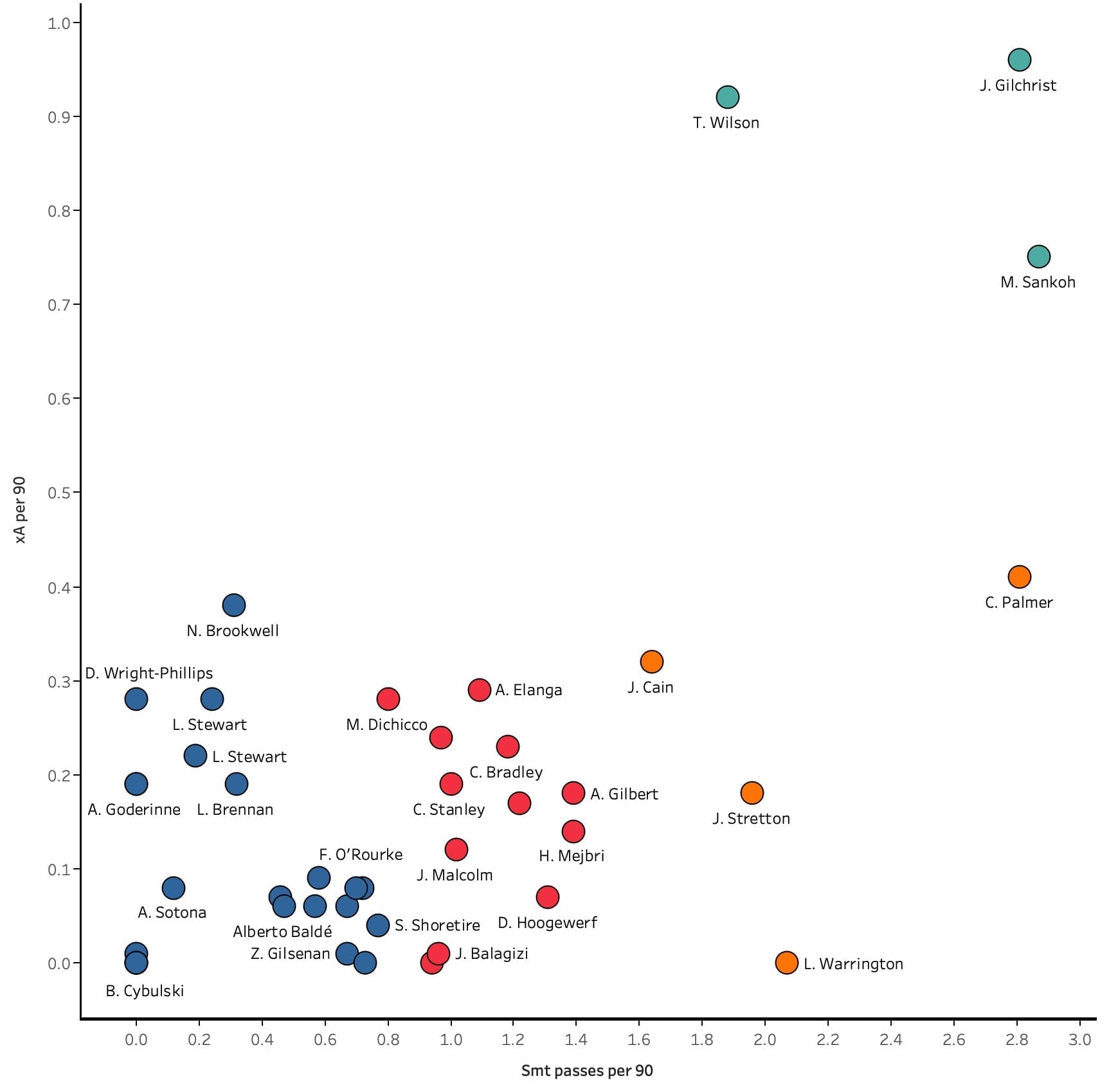
Josh Gilchrist is the standout player in this test. The Newcastle midfielder can play a range of positions in the midfield, including CAM where he can impose himself on the game. The youngster averages 2.81 smart passes per 90, this leads to an xA90 of 0.96, more than any other player in the data set. Looking back at his performance in the previous tests we get a clearer picture of the 17-year-old. The Newcastle teen averages just 0.08 goals per 90 from an xG90 of 0.31. This tells us that Gilchrist is a playmaker whose ability lies in feeding strikers using his clever passing.
Mohamed Sankoh of Stoke City is another player who tops the creative charts. The Dutch 16-year-old’s statistics are impressive for his age, averaging 2.87 smart passes per 90 and 0.75 xA90. In the next test, the striker also excels in his passing accuracy compared to his peers averaging 90% for both passing and forward passing. Looking back, his goal-scoring ability isn’t as outstanding but is respectable. The youngster is performing in line with his xG90 of 0.52 by scoring 0.51 goals per 90, which puts him around the average set by his peers.
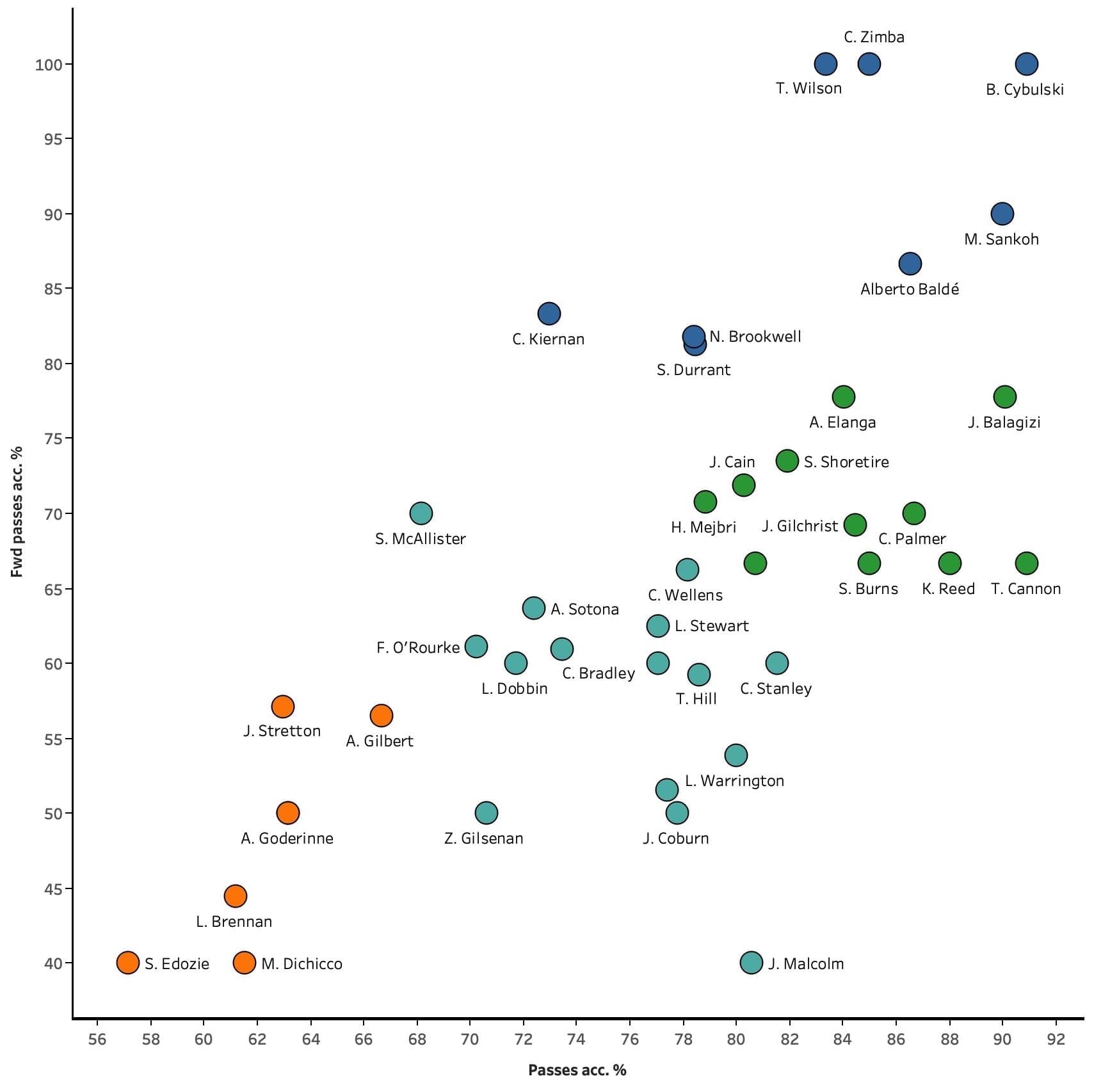
The next test in the creativity section looks at each player’s passing ability. By measuring passing accuracy against forward passing accuracy, we get can isolate the players who are reliable on the ball as well as those who are adept at playing forward with a high degree of accuracy.
18-year-old Chanka Zimba is a leading player in this category. The Blackburn striker is an interesting player who has spent time at centre-back as well as upfront. The Englishman scored eight goals in the 2019/20 season, where he averaged 0.87 goals per 90. On top of his ability to find the net, the Blackburn centre-forward’s passing also impresses, where he averages 100% accuracy for forward passes and 85% overall passing accuracy. This ability to keep the ball and find teammates, along with the talent to finish off a move make Zimba an exciting prospect.
The final section moves away from direct goal impact and looks at an important aspect of attacking football, penetration.
Technical Dribbling
In this test, we measure each player’s number of dribbles per 90 against their success rate in order to identify players who are adept with the ball at their feet. This is also a useful test to identify the players who make the right choices, knowing when best to dribble and the opportune moment to release the pass.
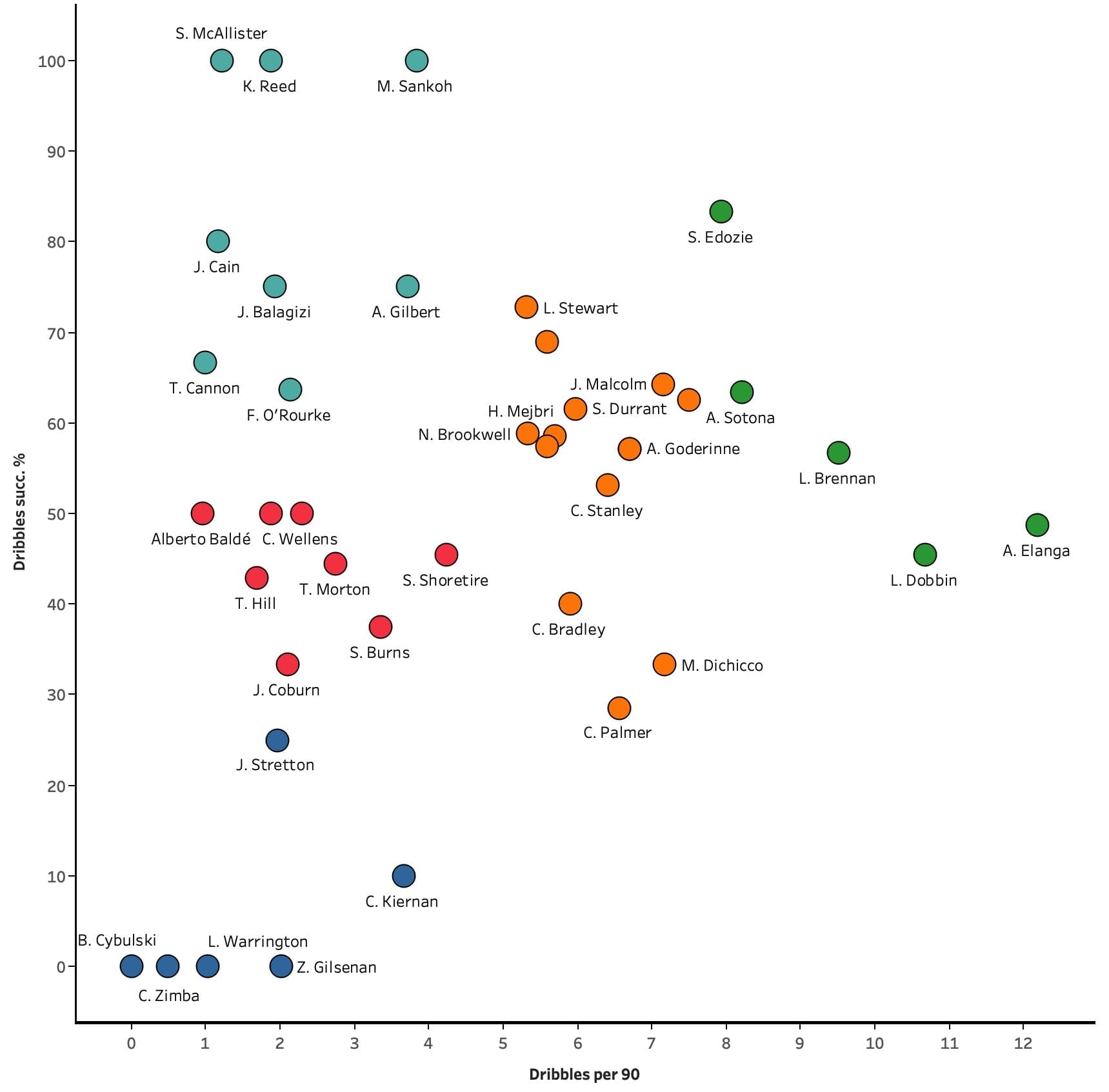
Sam Edozie, who we have previously discussed, comes to the fore again here. The youngster attempts 7.94 dribbles per 90 with a success rate of 83.3%. There are other players with either a higher dribbling frequency or better success rate, but no other player is performing that many dribbles with a similar success rate as the Man City teen.
Manchester United’s Swedish attacker, Anthony Elanga, is another interesting player. With the ability to play anywhere across the front, Elanga has the attributes to affect the game from a number of positions. The youngster scored seven and made three assists in the 2019/20 season, giving him a goal 29% goal participation figure. On top of his direct impact, the Swede’s dribbling statistics are exciting. Attempting 12.19 dribbles per 90 indicates a high level of confidence from the attacker whose frequency is more than any other player. Elanga also achieves an average success rate (48.7%) which is impressive given the number of dribbles he attempts. These statistics make for exciting reading for a player looking to catch the eye of Ole Gunnar Solskjær.
The Final Shortlist
After running multiple tests we have been able to identify some of the most exciting players in the U18 Premier League. This section is a final shortlist for the top 3 players based on the tests.
Goal-Scorer – Tom Cannon

It was hard to look beyond Cannon in the search for a natural goal-scorer. The youngster’s impressive goal tally – averaging 1.34 goals per 90 – and his ability to perform above his xG (0.52 xG90) shows an ability to take more chances than he should. His game centres around putting the ball in the net as we’ve seen, so his xA90 is just 0.06, however, he boasts a 90% passing accuracy, meaning when he’s paired with a creative force Cannon will thrive in front of goal.
Playmaker – Cole Palmer

Palmer is my favourite player on this list, and arguably the most exciting player in the division. The attacking midfielder possesses everything required to become a top player. The data has shown that the Man City man can score goals, take players on and keep possession both looking forward and in attacking cycles. An exciting future lies ahead for this potential star who may be moved out on a loan move as he looks for competitive minutes before attempting to break into the first team in the years to come.
Technical Dribbler – Anthony Elanga

The search for an exciting technical dribbler came down to two players. In the end, Elanga pipped Edozie onto the shortlist because of his superior passing statistics. The Swede’s overall passing accuracy of 84.02% on top of his forward passing accuracy of 77.78% puts him above average compared to his peers. The Swede’s technical ability combined with his passing and finishing allows him to contribute to both goals and assists making him a force in the attacking third. I am interested to track this player’s development going forwards.
Conclusion
In this data analysis, we have delved into the data behind some of the U18 Premier League’s most promising players. Using the statistics and comparing the players across a broad range of attacking metrics we have identified players who excel in specific offensive areas. Going further we have used this information to create a top-3 shortlist showing the most exceptional players identified by the data.
These players are still very young and in a vital period in their career where game time, hard-work and staying injury-free is paramount to development. As they enter into professional contracts, loan opportunities for these youngsters who go in search of first-team experience may present themselves and could be a superb bit of business for any lower league team able to snap them up for a season.





Comments